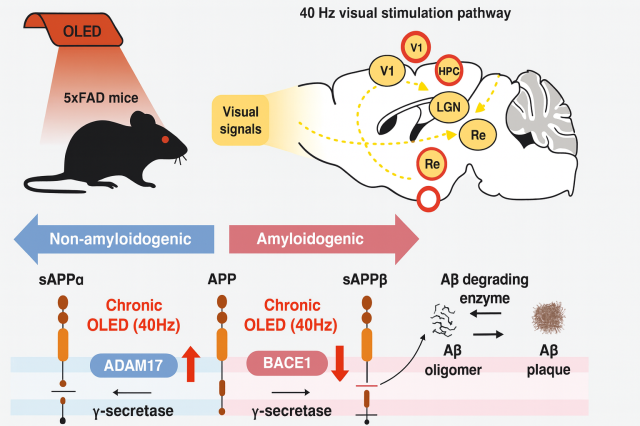
SEOUL, November 24 (AJP) - The Korea Advanced Institute of Science and Technology (KAIST) said on November 24 that its researchers have confirmed that a specific color of OLED light can reduce a key Alzheimer’s disease protein and improve memory in animal models, suggesting a possible new direction for non-drug treatment. The work was carried out with the Korea Brain Research Institute.
The team tested three OLED colors, blue, green, and red, using a platform that keeps brightness even and avoids the heat and uneven light problems found in regular LEDs. They compared the lights under the same conditions, including brightness, exposure time, and a 40-hertz flicker rate. According to the researchers, the red 40 hertz light showed the clearest improvement in both Alzheimer's-related proteins and memory performance.
To put it simply, the team shone the lights on early-stage Alzheimer’s model mice for one hour a day over two days. Even in that short period, red and white lights helped the animals remember better, and the harmful protein amyloid beta, often called plaque, decreased in key brain regions such as the hippocampus. Levels of ADAM17, an enzyme that helps clear plaque, increased as well.
The red light also lowered IL-1 beta, a molecule linked to brain inflammation, which the researchers said indicates an anti-inflammatory effect. They added that animals showing a larger drop in plaque tended to show a bigger jump in memory performance, suggesting a direct link between the two.
In mid-stage Alzheimer’s models, red light again showed a clearer pattern. After two weeks of exposure using the same frequency and brightness, only the red light produced a significant reduction in plaque, although both red and white improved memory.
At the molecular level, the differences were more pronounced. Red light increased ADAM17 and decreased BACE1, an enzyme that helps create plaque. In other words, red light both reduced plaque production and boosted plaque removal. White light, by comparison, only lowered BACE1.
To understand what happens in the brain when the light is applied, the team tracked c-Fos, a marker that switches on when neurons are active. They found that the visual cortex, thalamus, and hippocampus were all activated, indicating that the stimulation traveled through the brain’s visual and memory-related circuit.
Because the OLED system delivers even brightness regardless of movement, the researchers said it offered consistent results and overcame the technical limits of LEDs. The platform also allows fine control of color, brightness, flicker, and exposure time, which they believe could be useful in future personalized treatment studies.
Noh Byung-joo from the KAIST team said the study proves the importance of standardizing color in light-based brain stimulation and shows that red OLED produces key effects across disease stages. Professor Choi Kyung-cheol said the even brightness OLED platform makes it easier to evaluate safety and repeat results, adding that wearable red OLED devices may become a new treatment option in daily life.
The findings were published online on October 25 in ACS Biomaterials Science and Engineering.
Copyright ⓒ Aju Press All rights reserved.




